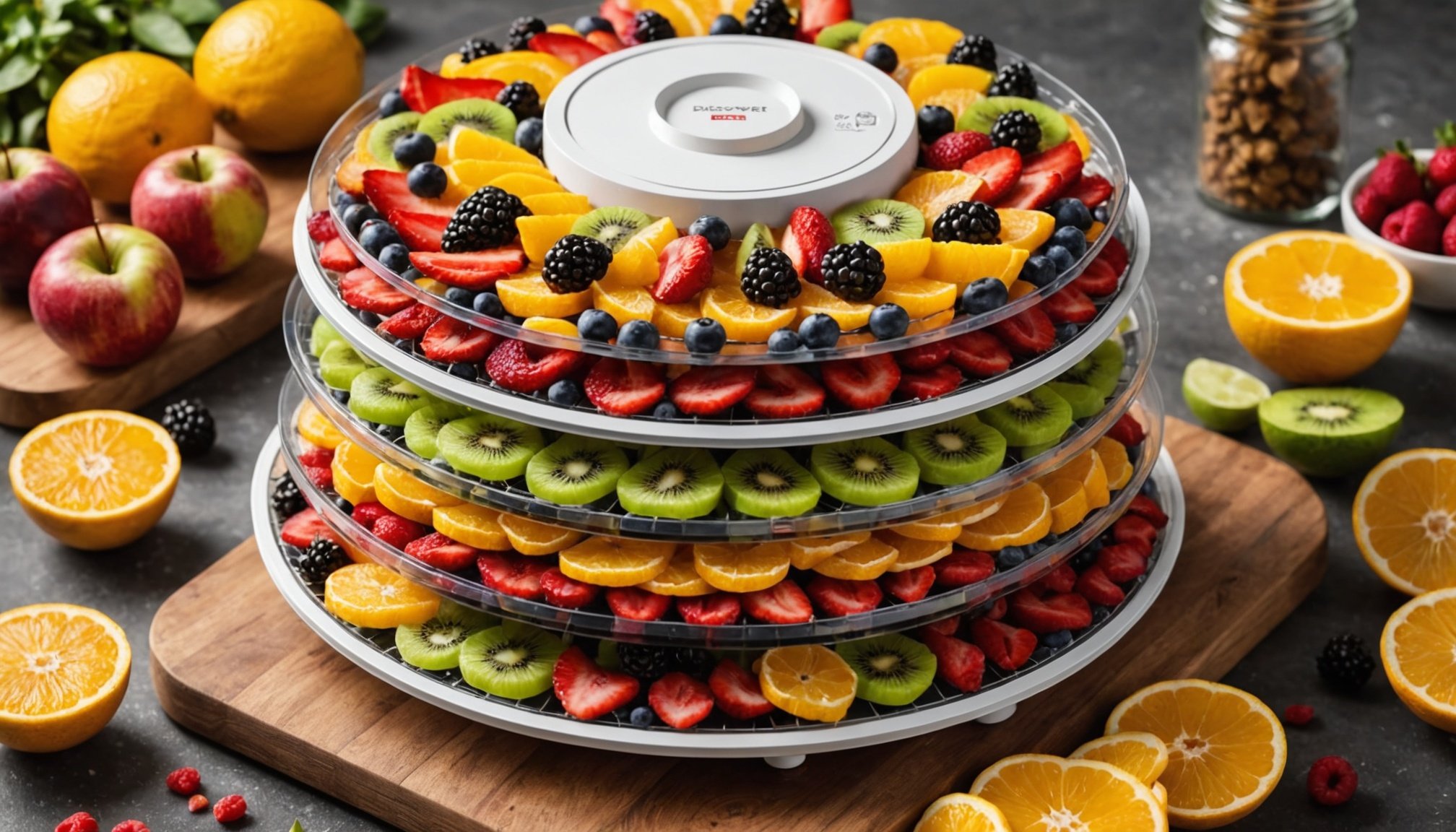Overview of Fruit Dehydrators
Fruit dehydrators are innovative appliances designed to remove moisture from fruits, transforming them into nutritious snacks. By applying low heat and a fan, dehydrators circulate air, causing the water content in the fruit to evaporate. This process preserves the fruit’s natural flavours and nutrients while significantly extending its shelf life.
The benefits of dehydrating foods at home are numerous. Not only can homemade snacks made with dehydrators be healthier without added sugars or preservatives, but they also offer a cost-effective alternative to store-bought options. Dehydrated fruits can be easily stored and enjoyed year-round, providing a convenient snack option for busy lifestyles.
Also read : Essential Features to Look for When Choosing a Multi-Tier Oven for Gourmet Cooking
There are several types of fruit dehydrators available to suit different needs:
- Stackable tray models, which are compact and perfect for limited kitchen space.
- Shelf models, which offer more capacity and uniform drying, suitable for serious home dehydrating enthusiasts.
- Vertical airflow dehydrators, ideal for smaller batches.
- Horizontal airflow dehydrators, providing even drying for diverse ingredients.
Each type has its unique features and advantages, catering to a variety of preferences and requirements.
This might interest you : Top Dishwasher Features to Safely Sanitize Baby Bottles for Your Little One
Top Fruit Dehydrators on the Market
Explore the best fruit dehydrators with this comprehensive buying guide. Examine product reviews and understand key considerations before making a purchase.
Overview of Top Picks
When seeking the best fruit dehydrators, consider models renowned for their efficiency and effectiveness. Top picks often boast adjustable temperature controls and consistent airflow for even drying. Noteworthy choices frequently highlight their ease of use, making the dehydration process accessible to everyone. Reviews often praise dehydrators with diverse settings, suitable for various fruits and homemade snacks.
Comparison of Features
Understanding the features of each fruit dehydrator is crucial. Look for models with a significant drying area and innovative mesh trays to enhance airflow. Digital timers and clear displays are highly regarded for simplifying the dehydration experience. Some top models include expandable trays, increasing their capacity to suit growing needs.
Price Range and Value for Money
Price varies widely among leading models. Some premium units, equipped with advanced features, demand a premium price. However, cost-effective options still offer great value, particularly for beginners or those with budget constraints. Always assess value for money, considering not only price but also product effectiveness and durability through user ratings and reviews.
Tips and Techniques for Dehydrating Fruits
Creating delicious, homemade snacks with your fruit dehydrator can be a straightforward process. Start by properly prepping fruits: wash, peel, and slice them into even pieces to ensure uniform drying. Maintaining a consistent thickness is crucial, as it affects both texture and dehydration time.
When considering dehydrating techniques, set your dehydrator’s temperature according to the type of fruit. Recommended temperatures usually range from 135°F (57°C) for most fruits, but adjustments may be necessary depending on moisture content. Time varies too—apples and bananas, for instance, might take 6-12 hours, while strawberries can require 8-10 hours.
Avoid common mistakes, like overcrowding trays or stacking fruits excessively, as this hinders airflow and prolongs dehydration. It’s best to periodically rotate trays to achieve even drying.
Best practices include checking the moisture level throughout the process. Dehydrated fruits should be flexible, not brittle, indicating they’re ready for storage. Store them in airtight containers to preserve freshness and avoid exposure to humidity.
By following these guidelines, you’ll maximise your fruit dehydrator’s potential, creating tasty and healthy snacks with minimal effort.
Delicious Recipes for Homemade Snacks
Creating dehydrated snacks at home can be an enjoyable and rewarding venture, offering a variety of culinary inspiration. Discover some unique snack ideas and transform simple fruits into gourmet delights.
Sweet Fruit Chips
For a delightful treat, try crafting sweet fruit chips from apples, bananas, or pears. Slice fruits thinly, then sprinkle with a hint of cinnamon or nutmeg. Dehydrating them at 135°F (57°C) for 6-12 hours develops a perfect, crispy snack. Enjoy them as a standalone delight or as a topping for yogurt.
Savory Fruit Blends
Experiment with savory fruit blends for a refreshing twist on typical snacks. Consider pairing pineapples with a dash of chilli powder, or mixing mango slices with a pinch of salt and pepper before dehydration. These bold flavours can serve as a tantalising addition to salads or cheese platters.
Unique Snack Ideas
Get creative with your fruit dehydrator by making fruit leather or gummy snacks. Puree your chosen fruits and spread the mixture evenly on non-stick sheets. Dehydrate until fully set. These snacks are fantastic for packing in school lunches or as an energetic boost for outdoor adventures. Embrace the benefits of dehydrating and enjoy a world of flavours.
Maintenance and Care of Your Dehydrator
Proper dehydrator maintenance ensures longevity and efficient performance. Regular cleaning is crucial. After each use, disassemble trays and remove any residual fruit remains or debris. Most trays are dishwasher safe, making cleaning convenient and thorough. For trays not compatible with a dishwasher, use warm, soapy water and a gentle brush to prevent buildup.
When it comes to the appliance’s exterior, a simple wipe-down with a damp cloth suffices. This not only maintains cleanliness but also prevents the accumulation of dust, which can impede airflow if not regularly removed.
Storage and care are equally important. Always store your dehydrator in a cool, dry place to avoid potential moisture damage. It’s advisable to keep the cord wound neatly, preventing frays and maintaining the integrity of electrical components.
Troubleshooting common issues involves understanding basic mechanics. If overheating occurs, make sure airflow is not obstructed. Cleaning the fan regularly can prevent this issue. Address unusual noises by checking for loose parts and ensuring proper setup.
By following these maintenance tips and cleaning tips, you ensure your fruit dehydrator remains a reliable appliance for producing healthy, homemade snacks over the years.
Essential Features to Consider
Choosing the right fruit dehydrator can significantly enhance your ability to create homemade snacks, yet the selection process might be daunting. Capacity is one of the most critical aspects to evaluate. A larger dehydrator accommodates more fruit, enabling you to produce ample snacks in one go, optimal for families or frequent users.
Ease of use is another key feature. Models with digital controls, adjustable settings, and clear displays simplify the dehydration process, making them accessible even for beginners. Automated timers are highly beneficial in ensuring precise drying times without constant monitoring.
Energy efficiency is a pragmatic concern as well. Choosing a dehydrator with low energy consumption ensures year-round usage without hefty power bills. For maintenance, consider appliances with dishwasher-safe trays, facilitating ease of cleaning and hygiene.
Lastly, assess the technological features. Devices equipped with continuous airflow systems deliver evenly dehydrated snacks by eliminating hotspots. Innovative features, such as mesh trays for enhanced airflow, bolster efficiency. By focusing on these aspects, you can select a dehydrator that seamlessly aligns with your needs, optimizing the benefits of dehydrating at home.
User Testimonials and Experiences
Engaging with customer reviews and understanding their genuine experiences provides valuable insights for prospective buyers. Many users share success stories, showcasing how integrating fruit dehydrators into their routines has enhanced their culinary repertoire. They often highlight how easy production of homemade snacks becomes a family favorite. For instance, one family found delight in crafting custom fruit chips for weekly school lunches, quickly making it a much-anticipated treat.
However, alongside the positive feedback, users also raise issues. A common challenge is uneven drying, prompting some users to recommend models with adjustable trays for consistent results. Brands have been responsive, offering troubleshooting guides and more flexible setting options, addressing these common issues effectively.
Furthermore, tips from experienced users can vastly improve your dehydrating journey. One useful piece of advice is to experiment with dehydration times and temperatures gradually, allowing new users to tailor settings to their specific preferences. Advice such as coating trays with a light layer of oil or using parchment paper helps prevent sticking, ensuring a smooth removal process. By learning from these experienced perspectives, newcomers can navigate potential pitfalls and optimise their dehydrator for the best snacks.











